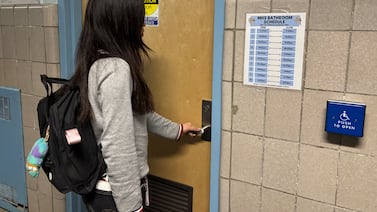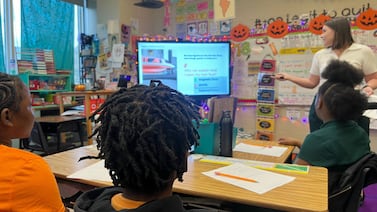Sign up for Chalkbeat New York’s free daily newsletter to get essential news about NYC’s public schools delivered to your inbox.
Almost three years ago, New York City officials declared victory on a major project: outfitting every public school classroom with air conditioning.
Yet after spending nearly half a billion dollars to upgrade outdated electrical systems and purchase new units, nearly 1 in 5 classrooms are still at risk of overheating.
About 18% of instructional spaces in city public schools did not have access to air conditioning last school year, according to an analysis of city data by the Independent Budget Office. Among classrooms dedicated to special education support, 22% did not have access to cooling units.
Chalkbeat previously found some students and educators were left sweltering even after the Education Department said its AC for All initiative was complete. The latest data show AC access remains a widespread issue.
“You got a lot of people running around patting themselves on the back about that, but there are still a lot of spaces that don’t have air conditioning,” said Tom Sheppard, a Bronx parent who serves on the city’s Panel for Educational Policy, which votes on Education Department contracts and other policy decisions.
When former Mayor Bill de Blasio launched AC for All in 2017, he framed the effort as essential to ensuring students have comfortable spaces to learn and a response to families that had long complained about stifling classrooms. But the program was a one-time infusion, leaving the subsequent cost of repairing or replacing AC units to individual schools. Some administrators say they don’t have money in their budgets to address broken units, leading to a patchwork of air conditioning coverage.
“They did ‘AC for All,’ but what’s the idea for replacing [them]?” said Stacey McStine, an assistant principal at P.S. 279 in Brooklyn. The school’s PTA kicked in some money for air conditioners years ago, but some units are now past their useful life, McStine said, and city officials did not replace all of them through the air conditioning program.
On hot days last school year, some classes had to be moved to the auditorium, which is air conditioned, disrupting instruction. The school’s custodian was able to track down portable AC units for preschool classrooms, though they felt more like a fan.
“They’re babies. They need AC, and we’re running on a portable,” McStine said.
City officials did not explain why maintaining or replacing air conditioning should fall to individual schools unlike other building maintenance costs, noting only that the Education Department has not historically paid to maintain window AC units.
“The AC for All initiative took important steps to cool our schools, and while our custodial engineers work hard to maintain AC units, the repair and replacement of units is the responsibility of our dedicated school leaders,” department spokesperson Jenna Lyle wrote in a statement.
The AC for All initiative also did not guarantee air conditioning in every space where students learn. Converted classroom spaces that were not originally designed for instruction were excluded — a noteworthy exception as schools may increasingly lean on makeshift spaces for instruction to comply with a mandate to reduce class sizes. The program also left out rooms without windows and a slew of other spaces such as gyms, auditoriums, and libraries.
Air conditioning access is an increasingly urgent issue. School years in New York City regularly include more than 30 days of temperatures of at least 80 degrees, and extreme temperatures are likely to become more frequent because of climate change. Some studies, though not all, suggest student learning suffers in hotter temperatures.
Lack of air conditioning could also pose additional logistical headaches for school leaders this coming school year. Under a state law that takes effect this September, schools will no longer be allowed to send students into spaces hotter than 88 degrees, forcing administrators to find alternative spaces on sweltering days. City officials did not say whether schools could consider remote instruction as an alternative.
Some data show AC for All didn’t lead to sweeping change
Even as the city purchased at least 19,000 AC units and upgraded electrical systems in roughly 700 buildings, it is unclear how much of a dent the air conditioning program made.
When AC for All launched in 2017, officials said 26% of city classrooms were unairconditioned — or 11,500 rooms — though the true number turned out to be closer to 13,000 thanks to a miscount.
By 2021, 20% of classrooms lacked AC based on data city officials publicly reported. That figure dropped to roughly 11% by the summer of 2022. Later that year, Education Department officials said the project was “completed” and stopped releasing reports tracking the program.
But separate data analyzed by the city’s Independent Budget Office shows that over the past eight years, the city only increased classroom air conditioning coverage by a little more than 2 percentage points — from 20% of classrooms lacking AC in the 2016-17 school year to 18% last school year.
Some of the discrepancy may be related to differences in how the IBO and Education Department classify whether a room is used for instructional purposes and therefore is eligible for the air conditioning program.
The data sources are also different. The figures analyzed by IBO came from annual principal surveys while the figures released publicly by the Education Department to track the progress of AC for All were based on walkthroughs conducted by other department staff.
Education Department officials did not dispute the IBO’s findings. Kevin Ortiz, a spokesperson for the School Construction Authority, noted that the IBO data is based on self-reported information and may not be fully accurate. IBO officials said those figures are supposed to be periodically validated.
The program’s costs also turned out to be far higher than initially estimated. A 2017 press release said the Education Department planned to spend nearly $29 million over five years to purchase and install the units with another $50 million in capital costs for electrical and other upgrades.
The Education Department’s costs grew to at least $39.6 million though officials did not offer a final tally. Meanwhile, the capital costs soared to $460 million, according to Ortiz. He said the $50 million figure came before the agency had actually assessed the number of classrooms that needed electrical upgrades and retrofits.
Despite the investment, some students said they still deal with uncomfortably hot classrooms.
Autumn Wynn, a junior at Park Slope Collegiate, said her social studies class last year did not have a working air conditioner. That made it challenging to concentrate, she said, especially as the room filled with body odor.
The heat also affected instruction, as her teacher sometimes pivoted to showing YouTube videos or offering online quizzes.
“It affected them teaching,” Wynn said. “It’s just so hot that no one can think straight.”
Alex Zimmerman is a reporter for Chalkbeat New York, covering NYC public schools. Contact Alex at azimmerman@chalkbeat.org.






